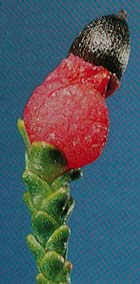
Ripe seed (Webb and Simpson 2001).
Distribution map (Metcalf 2002).
Lepidothamnus intermedius
Yellow silver pine, mountain pine.
Syn: Dacrydium intermedium T. Kirk 1877. See Dacrydium for details. Type locality: Kirk gives several localities. Kirk's t. 20 may be accepted as indicating the type form (Allan 1961).
Small, straight tree up to 15 m tall and 60 cm dbh with spreading branches. Bark brown-grey, shed in small platelets, under which the new bark is red-brown. Leaves on juvenile plants 9-15 mm long, spreading, limp, faintly keeled, narrow-linear-subulate, acute, recurved. On slightly older plants the leaves tend to spread around the branchlet, becoming shorter and more scale-like. Adult leaves 1.5-3 mm long, imbricate, appressed, rhomboid, obtuse, keeled, coriaceous, appearing to be arranged around the branchlet in four rows. Pollen cones abundant, solitary, terminal, 5-6 mm long, c. 2 mm wide; the apiculus broadly triangular, obtuse. The ovule is solitary, terminal, the final 3-4 scale lvs thin; the ovule is erect, the epimatium not more than one-quarter the length of seed. The seed is 3-5 mm. long, narrow to broad-oblong, nutlike, black, blunt or with a minute point. The wood is red-yellow. The ovule of the female appears in November among the leaves at the tip of the branchlet, maturing over the next sixteen to eighteen months. Male cones are ripe by late November and pollinate in early December (Allan 1961, Dallimore et al. 1967, Salmon 1996, Metcalf 2002).
New Zealand: scattered in the North Island from the Bay of Islands southwards, but it is more common on the West Coast of the South Island, and it is the principal tree in the swamp forests of Stewart Island. It is a slow-growing tree, found from sea level to about 900 m in regions of very wet climate (Salmon 1996, Metcalf 2002). Hardy to Zone 8 (cold hardiness limit between -12.1°C and -6.7°C) (Bannister and Neuner 2001).
No data as of 2023.02.21.
See Conifers of New Zealand for a review of the historic role of forests in native and European cultures of New Zealand.
The reddish-yellow wood is highly resinous and very inflammable, but very strong and durable. It was formerly used for railroad ties, boat-building, and for telegraph poles (Dallimore et al. 1967), but now logging has largely ceased.
I have not found it in habitat. Salmon (1996) shows it by a bog on Mt. Kaitarakihi in the southern Coromandel Range. I have also heard that it is relatively common on Great Barrier Island, and Trevor Hinchliffe (2003.02.20 e-mail) reports that it is very common west of Nelson on the South Island.
The epithet signifies that characters are intermediate, compared to other species of Lepidothamnus.
Allan, H. H. 1961. Flora of New Zealand. Volume I, Indigenous Tracheophyta. Wellington: R.E. Owen Government Printer.
Kirk, T. 1877. A revised Arrangement of the New Zealand Species of Dacrydium, with Descriptions of new Species. Transactions and Proceedings of the Royal Society of New Zealand 10:383-391 (as Dacrydium intermedium; accessed 2011.03.27).
The New Zealand Plant Conservation Network, accessed 2010.11.22.
Last Modified 2025-02-22